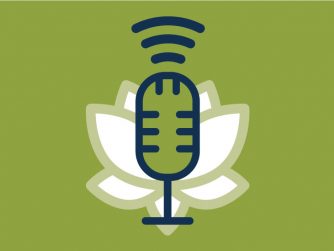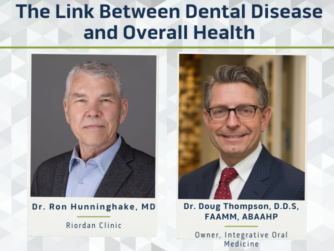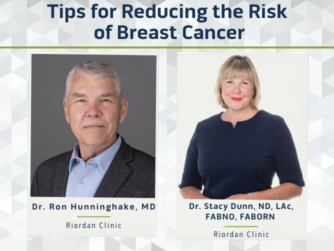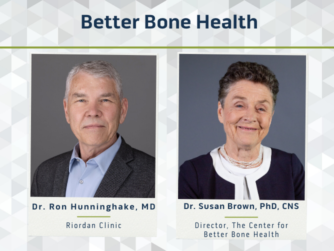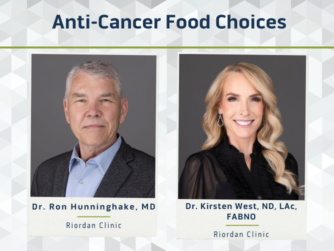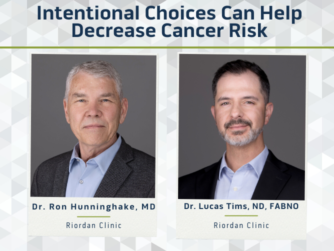In this episode, Dr. Ron Hunninghake interviews Dr. Dustin Moffitt who specializes in pain management and regenerative medicine. They discuss some of the main causes of pain as we age, supplements that can help with pain, and natural interventions the may be able to prevent surgery.
Thank You to This Episode’s Sponsor
Episode Transcripts
Disclaimer: The information contained on the Real Health Podcast. And the resources mentioned are for educational purposes only. They are not intended as, and shall not be understood or construed as medical or health advice. The information contained on this podcast is not a substitute for medical or health advice from a professional who is aware of the facts and circumstances of your individual situation. Information provided by hosts and guests on the Real Health Podcast or the use of any products or services mentioned does not create a practitioner patient relationship between you and any persons affiliated with this podcast.
Intro: This is the Real Health Podcast brought to you by Riordan Clinic. Our mission is to bring you the latest information and top experts in functional and integrative medicine to help you make informed decisions on your path to real health.
Dr. Ron Hunninghake: Welcome everyone. This is Dr. Ron Hunninghake for the Real Health Podcast here at Riordan Clinic. And it’s my honor today to have Dr. Dustin Moffitt who is our pain specialist and regenerative medicine specialist up in the in the Hays area. And so, Dustin, how are you doing today?
Dr. Dustin Moffitt: Doing pretty great. It’s the end of the Workday. We get to go home.
Dr. Ron Hunninghake: Well we thought what we would talk about today is something that is one of the main reasons patients come to see us and that is a pain. And we want to kind of look at how this ties into aging because Hey, you know, I just turned 70 and I’m noticing that pain is a little bit more of my life too. What is it about getting older? That seems to create more pain?
Dr. Dustin Moffitt: It’s compounded. So obviously as we age, our bones often deteriorate. So osteoarthritis tends to set on and per our discussion, I know everybody wasn’t involved in that, but sometimes it’s chronic viral infections or chronic infections or some kind of a chemical toxicity. A lot of men as they age, as their testosterone declines, I’m seeing them complain about joint pain and lo and behold, you restore their testosterone levels to what they were when they were a little bit younger. And they stopped complaining about quite so much joint pain,
Dr. Ron Hunninghake: Same way with women too, if we do bio-identical hormone replacement therapy. Absolutely.
Dr. Dustin Moffitt: And I would say estrogen does play a role into their joint pain as well.
Dr. Ron Hunninghake: Well, I mean, is this a necessary part of aging? What sort of things do you, when people come in complaining about getting old and achy, what sort of things do you initiate discussion discussing with them?
Dr. Dustin Moffitt: The first thing I start with, Ron, is going to be an exercise routine. So if somebody is not moving enough, our lymphatic system, our muscles, our bones, everything wants to stay mobile. And what is one thing that we see in the elderly population is a lack of mobility, right? So the less mobile you become, the more it hurts to increase any kind of mobility. We’re seeing a lot of frozen shoulders. We’re seeing hip mobility just rapidly decrease. When those decrease, then you see muscles mass and status of those and the ability of them to move in the way they should rapidly decrease too.
Dr. Ron Hunninghake: Use it or lose it
It’s even more so as we get older. And another part that I know you’ve written about is muscle as medicine, a lot of people as they age because of their sedentary lifestyle, and just, I don’t know, maybe because of pain, they don’t move as much. And so then they start to lose muscle mass. How does that affect us?
Dr. Dustin Moffitt: Well, the medical term is called sarcopenia, right? When we lose that muscle mass, we’re just wasting away. Muscle is one of our biggest metabolic balancers and metabolic disease over this last couple of years is become one of the biggest hit items, right? It is something that really should be addressed for total health all around. If your metabolism is off, everything else is going to be off. And muscle can truly be a status of health. If you are lacking that muscle, it’s going to be a lot harder to make up for the differences. So I honestly like to see anybody over their thirties lifting some weights. Nobody has to be a big meathead. You don’t have to be some bodybuilder, just move some weights, pick them up, put them back down you know, really encourage that body to stay strong and healthy throughout all of our years.
Dr. Ron Hunninghake: So we, we can’t leave out nutrition. How does diet and nutrition play into aging and pain?
Dr. Dustin Moffitt: As we know, we age more quickly when we have, they’re called AGEs, right? It’s called advanced glycating end products and increased oxidative stress increases the amount of AGEs that we actually will develop. And it’s speculated due to what is called telomere shortening. I know that’s getting advanced pretty quick, but essentially it’s just a way that our DNA can replicate and it becomes less efficient, right? So if we don’t have as much genetic coding behind us, we’re going to start seeing errors. And then that’s going to rapidly decline our age as well to where our health status just does not maintain. So if we can eat a diet that is full of this nutrition to reduce oxidative stress, which therefore reduces the amount of AGEs that we produce, we are not going to age as quickly, right. We need healthy fats in our diet.
We need plenty of protein to develop that bone mass and the muscle mass. We need plenty of antioxidants to yet again, heal our body, keep us well and healthy, keep our immune status up. So diet plays a very large role. And one other thing that we don’t think of as diet is water intake, water intake is incredibly crucial. Just one person increasing their water to the proper amount they should be drinking can help with fatigue, can help with joint pain. It helps us detoxify. We hear about all these detoxifying supplements and things on the market. Really, If we just move our bodies, eat well, poop every day and drink plenty of water, we’re already well on our way to detoxifying.
Dr. Ron Hunninghake: You know another factor in all of this, and it ties into this metabolic syndrome that you were talking about. So many people are gaining extra weight and their blood sugars are going up and they’re going, they’re going from pre-diabetes into diabetes. And the way we keep track of that, or the way a lot of doctors do it as a hemoglobin A1C. The hemoglobin A1C is an average blood sugar over your last 12 weeks or so. And, really what that’s measuring is that AGEs thing that you talked about, that oxidative stress, that high sugar causes to all of our tissues and it makes us a less limber. It changes the way the brain functions. People don’t remember things as well. So there’s a whole lot of aging that goes into getting too much sugar. Sugar will age you probably faster than anything else.
Dr. Dustin Moffitt: I completely agree.
Dr. Ron Hunninghake: Okay. So, a lot of what we’re talking about here is basic common sense stuff that people need to choose healthy foods with lots of colors, which are rich in phytonutrients, get the balance between the fats and the proteins. One thing I wanted to mention too was there’s a lot of these oxidized vegetable oils that are in processed foods that these cause a lot of aging to the cell membrane. And so our memory is not as good. The, all of the functions that go out the level of the cell membrane won’t work as well. If you’re eating too many of the hydrogenated, vegetable oils.
Dr. Dustin Moffitt: And even using what we would consider a healthy oil such as olive oil, right? If you apply too much heat to it, you’re there for breaking down a lot of the antioxidant nutrients that it is supplies. So really olive oil and I’m guilty of it too. Sometimes I will cook it on medium to high heat where really it’s like a low, medium heat type oil, or just a cold oil to be drizzled over your salads or something.
Dr. Ron Hunninghake: Avocado Oil and coconut oil would probably be better. Even butter, you know, good quality, butter, organic butter, preferably to keep the toxins out of it is better to cook with. Oh yeah. So are there specific supplements that seem to help out with the aging process, aches and pains that you like?
Dr. Dustin Moffitt: It it’s going to depend on that patient’s picture. So a one that’s kind of a hot ticket item right now would be nitric oxide, right. So as our body makes less nitric oxide, we’re going to see more rapid aging because our body needs nitric oxide for vasodilation to supply nutrients, to ourselves to heal. Right. So really a well-rounded one to get started with is assessing your nitric oxide levels or improving that. If they’re aging quickly because their hormones are off, there are a lot of different supplements out there that can boost hormones. A good well-rounded starting place is DHEA and adrenal adaptogens. So we have our products, adrenal revive and adrenal adapt, or just the DHEA, right? So those are all great boosters. Vitamin C is crucial for our adrenal health. When our vitamin C is depleted, it also gets depleted in our adrenal glands, which then we’re not going to produce as many of our corticosteroids, which would include some of that DHEA.
Let’s see some other ones for anti-aging and it depends, I know we’ve mentioned pain a lot, so I mean, if you’re feeling like you’re aging, because of all of your pain, then you want to utilize supplements that would help to reduce pain. Bromelain, quercetin, a really big one that I use quite often with those with inflammatory based pain is going to be some kind of a protein proteolytic enzymes, such as serrapeptase and then a boswellia and tumeric blend. So those three together when we, the serrapeptase is a fibrin inhibitor and in chronic pain pictures, it’s usually because they’re chronically developing more dense scar tissue. And the tissue is very, very painful. So when we put them on a fibrin breaker upper, like the serrapeptase it helps to alleviate some of that more intense development. And it will break down the inflammatory process. Then if you pair it with the boswellic acid, which is frankincense, and turmeric, which is curcuminoids, those are natural anti-inflammatories. Other aging, you know, as we talk about our real health all the time, if you are deficient in nutrients that are needed, the most important nutrient you need is the one that you don’t have, right?
Dr. Ron Hunninghake: You that’s right. Lowest. And so measurement – measure, measure, measure, is a big mantra here at the Riordan Clinic. Also, organic sulfur in the form of MSM. I’ve had really good success with that. It’s inexpensive. It’s very good for your joints. It helps maintain connective tissue. So, Hey, I, you mentioned nitric oxide. I just wanted to kind of throw this in the one lifestyle habit. That’s so crucial for healthy aging is good quality sleep. And what we see in a lot of people, especially the people that are suffering from metabolic syndrome, which we mentioned earlier, which can cause weight gain is that a lot of older people will start snoring at night and not getting a good quality sleep. And most people think of that, well, I need a C-PAP, but there are other ways to deal with it. It turns out that when you sleep with your mouth open, very often the tongue will fall back and cause that snoring thing. But what’s happening is you’re not breathing through your nose and correct me if I’m wrong, Dustin, that by nasal breathing, we make more nitrous oxide on our own. Whereas if you’re a mouth breather at night, you don’t make as much of that nitric oxide.
Dr. Dustin Moffitt: Some of the studies point that way. Yes. Yeah.
There’s a lot more to this conversation. And it’s coming up right after the break.
Advertisement: There’s a lot more to this conversation and it’s coming up right after the break. Today’s episode of the Real Health Podcast is brought to you by the Riordan Clinic Nutrient Store. The Nutrient Store is your resource for the highest quality nutritional supplements. Every supplement in the store is handpicked by the expert medical staff at Riordan Clinic, providing you with the best quality purity, consistency and effective dosing available visit store.Riordanclinic.org to shop online.
Dr. Ron Hunninghake: Anyway, what I encourage people to think about is that their mouth is open. There are really good quality mouth tapes that you can use at night that are comfortable. They keep your mouth closed. You’ll sleep quieter and better and deeper. And I know my wife has been very happy that I started using mouth tape. I’m not sure if it’s because I sleep better or if it shuts me up, I’m not quite sure what they’re also great during argument.
Okay. So this is this is this whole thing about mental health. You know, that people who are in pain are going to be more grouchy. And I think this is where we might want to get into a, you do a lot with dealing with people that have joint pains. What are you doing in the field of regenerative medicine That’s helping people deal with chronic joint pains?
Dr. Dustin Moffitt: So if they have areas that are very specific to joint pain, we treat that area. If it’s their whole body, we’re going to go after a whole body approach. Unless of course they know that they’ve injured their entire spine, which I do see several patients that, you know, it truly is from head to butt that that we’re treating their entire spine. It really is situational, but if you’ve got pain, you’re not going to be a, a healthy individual. Don’t ignore it, our body tells us we have pain for a reason, whether it be actually a localized pain or a lot of times, what do we see in those that struggle from chronic pain? Chronic depression, right? Or those that are chronically depressed, have a pain that they’re kind of ignoring. So we don’t know which one is which, but I can tell you that they heavily come into each other. And if your mental health is off because of that pain, we’re going to feel a lot older than we typically would on a daily basis.
Dr. Ron Hunninghake: And, you know, just to interject for a second, if you’re in pain, you’re not going to get out there and get your exercise. You’re, you’re probably going eat more junk foods just because you don’t feel like fixing a really good meal. It’s going to disrupt your sleep. So pain, if it’s not dealt with is a major lifestyle disruptor, and will set you on the wrong course in terms of not only aging, but it will set you up for a number of other health conditions if you don’t deal with it. So go ahead, tell me a little bit more about how you approach areas of specific pain.
Dr. Dustin Moffitt: So we have several options that we have to offer. It’s going to be Prolozone. But really that one, I don’t call as a separate option. I will include it in with dextrose prolotherapy and platelet rich plasma therapy. So really it kind of just boils down in between the two of those. The dextrose prolotherapy is pure and simple, a sugar water solution that I call the middleman approach or a flagging approach. It signals to your body that, Hey, come pay attention to this area and let’s get it healed up. Which is the first thing that happens when you get a new injury, right? You get bruised and that signals to your body, Hey, something happened here. Let’s, let’s fix this up. And sometimes in these chronic injuries, there was never a strong enough signal or our body didn’t have a strong enough response at that point. So that’s where we get these chronic injuries. Platelet rich plasma therapy I call skipping the middleman. So it is more direct because we can put those platelets there, which are growth factor drivers, which stimulate the most important one is going to be cartilage development. And a lot of the times when we see chronic pain, it is because of ligament and tendon laxity or scar tissue around the area. And the inflammation is just a secondary product to those first things that I talked about, ligament and tendon laxity and scar tissue.
Dr. Ron Hunninghake: Now you’re getting the platelet rich plasma from the patient themselves?
Dr. Dustin Moffitt: Yes. So, we do a blood draw and process that down, and then that goes back to them with the platelets. We get rid of the red blood cells, and we give them back the platelet rich plasma.
Dr. Ron Hunninghake: So what do you think the platelet portion does? How does that really help?
Dr. Dustin Moffitt: Like I said, it’s driving growth factors. So we get, we get new blood flow with VGF. We get new nerve development, which then of course, if it’s a poorly innervated area, that’s going to cause pain because your muscles aren’t going to be firing like they should. Right. But then, like I said, the most important one is going to be that we are stimulating cartilage development through our growth factors.
Dr. Ron Hunninghake: Are there signaling factors that pull in some stem cell regeneration or is that over oversold?
Dr. Dustin Moffitt: Are there stem cells that do this thing? The same thing? Yes. And I call it a laddered approach. So I would consider that Prolozone is at the bottom of the ladder. Next step would be dextrose prolotherapy, then platelet rich plasma therapy, then stem cells. But even then, there are lots of different kinds of stem cells of where they’re derived from. Right. We hear of umbilical derived. We hear of bone marrow derived. We hear of fat tissue derived. All of those are the most common ones that we see. Then there’s a newer category called exosomes and exosomes are exactly a signaling molecule. So what they are there is to signal the body to do something else. And a lot of exosomes are derived from stem cell products. Does that make them equivalent to live stem cells? Not necessarily. Does that mean that they can be paired with stem cells? Absolutely. Can they be used by themselves? Absolutely. So it’s really got to be a tiered approach to figure out what works best. Does that mean that PRP is a blanket ticket item for everything? Absolutely not. There are a lot of times that I’ll have patients come in for PRP and I’ll actually talk them into going with the dextrose prolotherapy instead, because the more you do the injections, the more you kind of see where things are far superior for.
Dr. Ron Hunninghake: Yeah, I’ve done a lot in the last seven to eight years with Prolozone where it’s injecting, numbing the area and then injecting ozone into the joint. I I’ve wondered it I’ve, I’ve told patients, it’s kind of like a reboot of the healing process. I’m wondering if you could kind of go through the steps of how Prolozone itself helps restore joint function.
Dr. Dustin Moffitt: The way I describe it very simply is that Prolozone is all about creating localized hydrogen peroxide, essentially. So we’ve all seen how hydrogen peroxide works on the outside of a wound, right? It’s a debriding agent, it kind of bubbles at the surface and creates a little bit more damage to then make a response to happen. With the ozone is there to create that hydrogen peroxide, that local tissue damage. So I almost say it enhances it. And tissue damage, I say, not negatively, but positively because we need a controlled injury to sometimes heal these chronic things. Then immediately that ozone will convert back to high grade oxygen, which you’ve done lots of these injections. What do we, what do we first see? We see a flush of blood or a flush of erythema, redness around the area. And that is your body sending all those nutrients, all those growth factors to that area. So Prolozone is a great thing. It just does not fit every single category. But I would say that for providers that are doing regenerative medicine that aren’t using ozone, they probably should step it up a little bit. I’ve seen, I used to do the regenerative injections without ozone, and I see far better results when we pair it with ozone.
Dr. Ron Hunninghake: It’s interesting that pain is an indication that the body is trying to bring our attention to the area of injury. It’s just that we have the pain, but very often there’s not enough there to reboot or restart the healing process. And so in many ways I see Prolozone as helping the body start to re-heal itself in a better way than what it was. It kinda like gets stuck in not healing. And this helps it start over again and do it right this time.
Dr. Dustin Moffitt: Well, and the other beautiful part about ozone that I didn’t talk about is ozone, ozonides break down cytokines, which are inflammatory drivers, right? So it’s a rapid reduction of too much inflammation, almost like a corticosteroid, but it doesn’t stay long lasting like a corticosteroid. So our body still is able to do what it needs to do to heal. Cause inflammation is needed for healing. Inflammation is not all bad if we didn’t have inflammation, none of us would be living right now. It’s the ongoing stuff that sucks.
Dr. Ron Hunninghake: Yeah. It’s chronic inflammation for which the, the intent of the inflammation never gets realized. And so we get stuck in a, in a blind loop where it just causes more and more damage. And instead of actually resulting in a better functioning joint or part of the body,
Dr. Dustin Moffitt: I agree.
Dr. Ron Hunninghake: So let’s, let’s just kind of, we’re going to have to kind of wind things up here and I’m, I’m kind of thinking about how we started with this discussion of pain and how it seems to be a common part of getting old. But I guess we should end on a positive note. That pain is a signal to us that we need to rethink what we’ve been doing in our general lifestyle habits. You know, we want to rethink the food we’re eating. We want to get the right kind of exercise. We want to make sure we’re not ingesting toxic factors like sugar. Sugar is a toxin in my book, sugar and these vegetable oils that have been hydrogenated stay away from those eat real foods. We want to get adequate amounts of sleep. And then if we’ve done everything we can do, then here at the Riordan Clinic, we, we refer to our patients as co-learners. And so that’s where you step in. And I step in to kind of help work with people to help them discover what it is they need to get beyond the chronic pain.
How’s that for kind of a summary?
Dr. Dustin Moffitt: I think you summarized it perfectly. So aging has, has you saw, there can be simple things, but sometimes we forget about the simple things and just getting back to it, get your butt in gear, eat some good food, get some sunshine, drink some water, or as I’ve seen before, we’re basically like complicated plants.
Dr. Ron Hunninghake: There you go. Well, I like the fact that as a naturopath, Dustin, you, you bring a kind of philosophy of dealing with the pain. I mean, and we’re talking about medical pain, you still bring a naturalistic philosophy to it so that we’re not just covering up the problem. We’re not just killing the pain. We are actually using the pain as an indicator of where we need to go, what we need to do to enhance the inherent healing process that the body has at its at its beck and call. But most doctors don’t know how to do that. And I I’ve, I’ve been so appreciative of, of the dimension of care that you’ve brought. I’ve referred a lot of patients up to you. My wife is a, is a fervent disciple of the stuff that you do because she was in really big trouble with her knee after the car wreck. And she was not, she was basically told that very likely she would need a, a new knee, a knee replacement. And so it’s really exciting to know that using these naturalistic approaches, we can help people regenerate function and improve the quality of their lives using these techniques.
Dr. Dustin Moffitt: And it’s always a pleasure to, to see the patients get better. Especially those that have been told that they need to have joint replacement. To me, you know, there are some cases where things just don’t work out, but a large majority of them, especially with knees, a large majority of knees, we’re able to get better without surgical interventions.
Dr. Ron Hunninghake: `Well, it’s Just like anything. If you let something go too long, it’s just, it’s going to be beyond repair. But I think the, the idea is, is that it probably a lot of people out there don’t know that these types of naturalistic approaches are available here in Kansas and the Midwest. And so we hope more people will take advantage of the types of resources that we have to offer. But again Dustin, thank you very much for the really excellent care that you’re providing up in the Northern part of Kansas and the Midwest. So thank you again and thank you everyone. You’re listening in and we’ll see at the next edition of Real Health at the Riordan Clinic
Outro
Thank you for listening to the Real Health Podcast. If you enjoyed this episode, be sure to subscribe and leave us a review. You can also find all of the episodes and show notes over at realhealthpodcast.org. Also be sure to visit Riordanclinic.org, where you will find hundreds of videos and articles to help you create your own version of real health.


